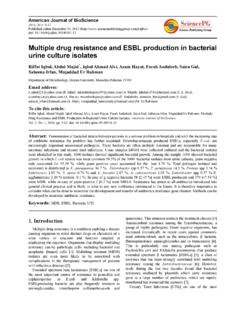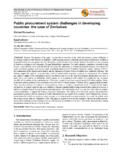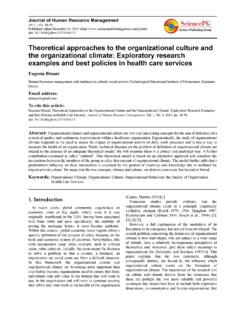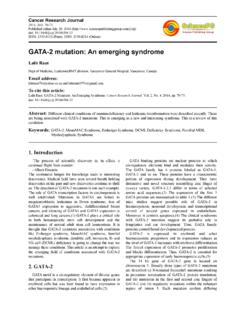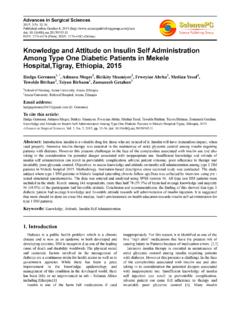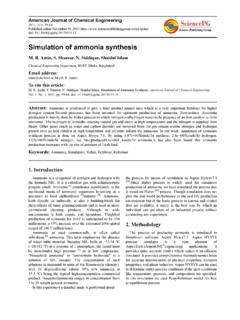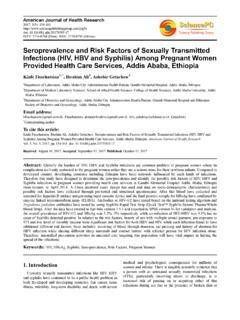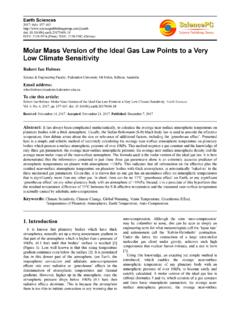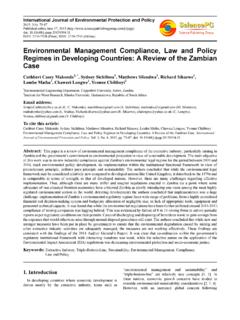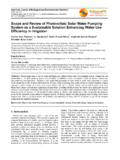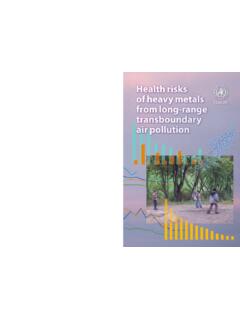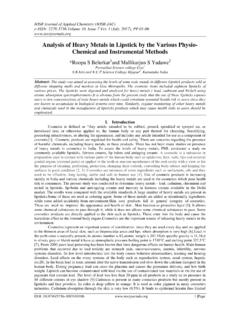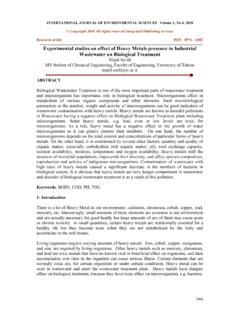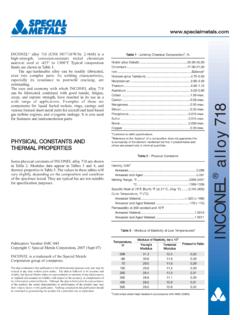Transcription of Heavy metal pollutants in wastewater effluents: Sources ...
1 Advances in Bioscience and Bioengineering 2014; 2(4): 37-43 Published online November 10, 2014 ( ) doi: ISSN: 2330-4154 (Print); ISSN: 2330-4162 (Online) Heavy metal pollutants in wastewater effluents: Sources , effects and remediation Oghenerobor Benjamin Akpor1, *, Gladys Onolunose Ohiobor1, Tomilola Debby Olaolu2 1 Microbiology Unit, Department of Biological Sciences, Landmark University, Omu- Aran, Kwara State, Nigeria 2 Biochemistry Unit, Department of Biological Sciences, Landmark University, Omu- Aran, Kwara State, Nigeria Email address: (Akpor O. B.), (Ohiobor G. O.), (Olaolu T. D.) To cite this article: Oghenerobor Benjamin Akpor, Gladys Onolunose Ohiobor, Tomilola Debby Olaolu. Heavy metal pollutants in wastewater Effluents: Sources , Effects and Remediation. Advances in Bioscience and Bioengineering. Vol. 2, No. 4, 2014, pp. 37-43. doi: Abstract: Heavy metals, also known as trace metals, are one of the most persistent pollutants in wastewater .
2 The discharge of high amounts of Heavy metals into water bodies leads to several environmental and health impacts. The exposure of humans to Heavy metals can occur through a variety of routes, which include inhalation as dust or fume, vapourisation and ingestion through food and drink. Some negative impacts of Heavy metals to aquatic ecosystems include death of aquatic life, algal blooms, habitat destruction from sedimentation, debris, increased water flow, other short and long term toxicity from chemical contaminants. Abundant amounts of Heavy metals present in soils cause reduction in quality and quantity of food preventing plants growth, uptake of nutrients, physiological and metabolic processes. Severe effects on animals may include reduced growth and development, cancer, organ damage, nervous system damage, and in extreme cases, death.
3 To help mitigate the negative impacts of Heavy metals on the health of humans, animals and the environment, a variety of remediation processes exists. These remediation processes are broadly classified into chemical and biological, although the latter is advocated in recent years. Biological remediation processes (microbial remediation and phytoremediation) are indicated to be very effective in the treatment of Heavy metal pollutants in wastewater . Microbial remediation is the restoration of the environment and its quality using microorganisms, such as bacteria, fungi, protozoan and algae while phytoremediation is the use of plants to degrade or accumulate toxic metals, thereby leading to a reduction in the bioavailability of the contaminant in the soil or water. This paper was therefore aimed at reviewing the Sources , impacts and remediation processes for Heavy metals in wastewater .
4 Keywords: Heavy Metals, Remediation, wastewater 1. Introduction Heavy metals are elements with an atomic density greater than 6 g/cm3; they are one of the most persistent pollutants in wastewater . They are also referred to as trace elements and are the metallic elements of the periodic table (Salem et al., 2000). The most common toxic Heavy metals in wastewater include arsenic, lead, mercury, cadmium, chromium, copper, nickel, silver, and zinc. The release of high amounts of Heavy metals into water bodies creates serious health and environmental problems and may lead to an upsurge in wastewater treatment cost. Heavy metals also occur in small amounts naturally and may enter into aquatic system through leaching of rocks, airborne dust, forest fires and vegetation (Fernandez and Olalla, 2000; Ogoyi et al., 2011). Their occurrence and accumulation in the environment is a result of direct or indirect human activities, such as rapid industrialization, urbanization and anthropogenic Sources .
5 The persistence of Heavy metals in wastewater is due to their non-biodegradable and toxicity nature (Jern, 2006). Some of the negative impacts of Heavy metals on plants include decrease of seed germination and lipid content by cadmium, decreased enzyme activity and plant growth by chromium, the inhibition of photosynthesis by copper and mercury, the reduction of seed germination by nickel and the reduction of chlorophyll production and plant growth by lead (Gardea-Torresdey et al., 2005). The impacts on animals include reduced growth and development, cancer, organ damage, nervous system damage and in extreme cases, death (Canada Gazette, 2010).To prevent the negative effects of Heavy metals toxicity in wastewater , there is need for adequate treatment of effluents before discharge to receiving 38 Oghenerobor Benjamin Akpor et al.: Heavy metal pollutants in wastewater Effluents: Sources , Effects and Remediation water bodies.
6 The ultimate goal for treatment is to eliminate any current or potential threat to human/animal health and the environment. Although chemical and biological treatment processes exist, biological processes are advocated in recent years because of the main drawbacks in chemical treatment processes. Biological processes are classified into two broad categories: microbial remediation and phytoremediation (USEPA, 2004). Microbial remediation is described as the restoration of the environment and its quality using microorganisms (bacterial, fungi, and yeast). The technique uses biological activity to reduce the concentration or toxicity of a pollutant . In some cases, the pollutants may first serve as a source of carbon needed for the growth of the microorganism first before the microorganism can help in the breakdown. In some instances, microbial remediation can occur without the implementation of any engineered step to enhance the process, referred to as natural attenuation or intrinsic microbial remediation.
7 It can also occur by the addition of genetically engineered microorganisms to enhance the naturally occurring process of degradation, referred to as engineered or enhanced microbial remediation. During microbial remediation, the microorganisms can be used at the site of contamination (in-situ) or off site of the contamination site (ex-situ) for remediation. The microbial remediation strategies for Heavy metal removal in wastewater include bioaugumentation, biosparging and biosorption (Igwe and Abia, 2006). Phytoremediation is the restoration of the environment and its quality using plants. It is described as an emerging green bioengineering technology for environmental cleanup that use plants for the removal of pollutants (Pilon-Smits, 2005). During phytoremediation in water, plants may degrade and accumulate a toxic metal or cause immobilization in the bioavailability of the contaminant.
8 This review was aimed at reviewing the effects, Sources and treatment processes for Heavy metal polluted wastewater effluents. 2. Sources of Heavy Metals in wastewater effluent The two main Sources of Heavy metals in wastewater are natural and human. The natural factors include soil erosion, volcanic activities, urban run offs and aerosols particulate while the human factors include metal finishing and electroplating processes, mining extraction operations, textile industries and nuclear power. Then main natural Sources of Heavy metal pollutants in wastewater effluents are volcanic activities, soil erosion, urban run offs and aerosol particles. It is reported that volcanic eruptions produce hazardous impacts to the environment, climate and health of exposed individuals. Apart from the deterioration of social and chemical conditions and the gases (carbon dioxide, sulphur dioxide, carbon monoxide, hydrogen sulphide) released during eruptions, various organic compounds and Heavy metals, such as mercury, lead and gold are also released.
9 The presence of these Heavy metals in water bodies is known to significantly deteriorate the quality of such waters. Several rocks and volatiles of volcanic origins are indicated to be responsible for the presence of metals in soils and waters. This is because the diffusion of acidic volcanic gases through water permeable rocks contributes to the hydrological material transfer in volcanic strata. The activities from volcanoes are reported to be responsible for the release of metals such as arsenic, mercury, aluminum, rubidium, lead, magnesium, copper, zinc and a host of others (Amaral et al., 2006). Soil erosion is also indicated to be a source of Heavy metal pollution in water. The two main agents of soil erosion are wind and water. During rainfall, sediment-bound Heavy metals is distributed to the soil. Water containing agrochemicals with toxic metal concentration drop this sediment bound metal in the soil even as it causes erosion (Kaizer and Osakwe, 2010).
10 During run-off due to erosion, Heavy metals, may be picked up and distributed to the environment. In some cases, during rainfall, some Heavy metal wastes are washed into poor drainage systems and subsequently into nearby rivers (Taiwo et al., 2011). In addition, some aerosol (fine colloidal particles or water droplet in the air, in some cases they can be gas) particles may carry different kinds of contaminant; like smoke cloud and Heavy metals. These Heavy metal containing aerosols usually accumulate on leaf surfaces in the form of fine particulates and can enter the leaves via stomata (Sardar et al., 2013). Some of the human Sources of Heavy metals in wastewater effluents are metal finishing and electroplating, mining and extraction operations, textiles activities and nuclear power. metal finishing and electroplating involve the deposition of thin protective layers into prepared surfaces of metal using electrochemical processes.
